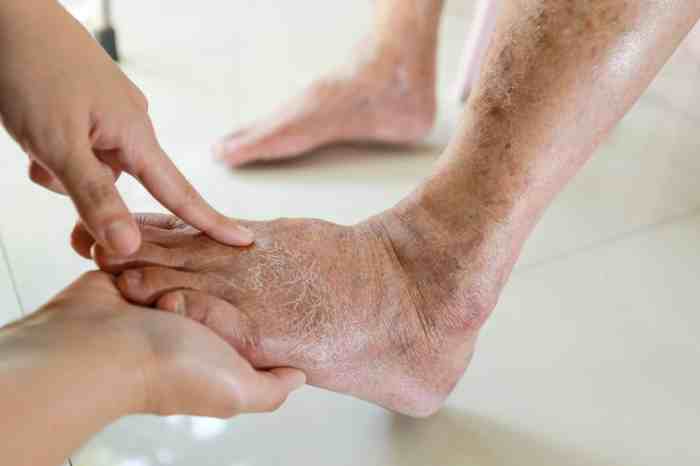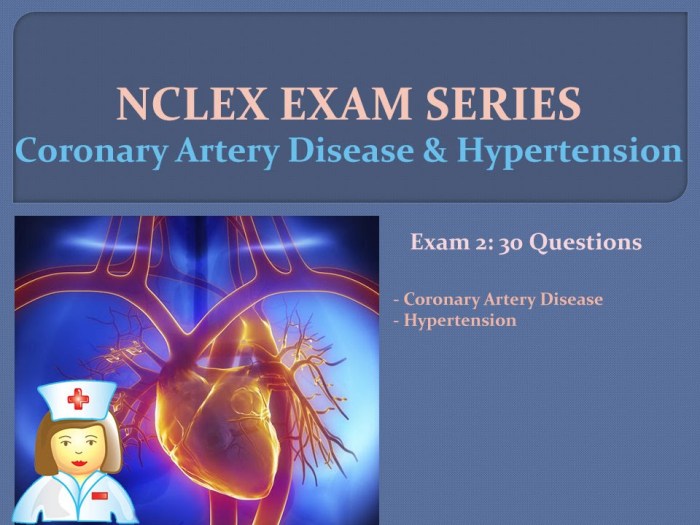Nclex questions peripheral arterial disease – Embark on a journey through NCLE-RX questions on peripheral arterial disease (PAD), a prevalent condition that affects millions worldwide. This comprehensive guide delves into the intricacies of PAD, providing a thorough understanding of its pathophysiology, clinical manifestations, management strategies, and nursing care.
From the underlying causes of PAD to the latest treatment modalities, this resource equips you with the knowledge and insights necessary to excel in your NCLE-RX exam and provide exceptional care to patients with PAD.
Pathophysiology of Peripheral Arterial Disease

Peripheral arterial disease (PAD) is a condition characterized by the narrowing or blockage of arteries in the limbs, leading to reduced blood flow to the affected areas. The underlying cause of PAD is atherosclerosis, a process where plaque builds up in the walls of arteries, causing them to become narrow and hardened.
Atherosclerosis occurs when cholesterol and other fatty substances accumulate in the inner lining of arteries. Over time, this accumulation forms plaques that can obstruct blood flow. In the case of PAD, these plaques typically develop in the arteries of the legs and feet, although they can also affect the arteries of the arms and head.
Risk factors for PAD include:
- Age (over 50 years old)
- Smoking
- High blood pressure
- High cholesterol
- Diabetes
- Obesity
- Family history of PAD
Clinical Manifestations of Peripheral Arterial Disease

The symptoms of PAD vary depending on the severity of the condition. In early stages, PAD may not cause any noticeable symptoms. As the condition progresses, however, symptoms may include:
- Leg pain or cramping while walking or exercising (claudication)
- Numbness or weakness in the legs or feet
- Coldness in the legs or feet
- Changes in the color of the skin on the legs or feet
- Slow-healing sores on the legs or feet
- Loss of hair on the legs or feet
- Erectile dysfunction in men
PAD is classified into four stages based on the severity of symptoms:
- Stage 1:Asymptomatic or mild symptoms
- Stage 2:Moderate claudication
- Stage 3:Severe claudication or rest pain
- Stage 4:Tissue loss or ulceration
The diagnosis of PAD is based on a physical examination, medical history, and diagnostic tests such as:
- Ankle-brachial index (ABI)
- Toe-brachial index (TBI)
- Doppler ultrasound
- Magnetic resonance angiography (MRA)
- Computed tomography angiography (CTA)
Management of Peripheral Arterial Disease: Nclex Questions Peripheral Arterial Disease

The goals of PAD management are to:
- Relieve symptoms
- Prevent further progression of the disease
- Reduce the risk of complications
Lifestyle modifications recommended for PAD patients include:
- Smoking cessation
- Regular exercise
- Healthy diet
- Weight loss (if overweight or obese)
- Control of blood pressure and cholesterol
Medications that may be used to treat PAD include:
- Antiplatelet agents (e.g., aspirin, clopidogrel)
- Statins (e.g., atorvastatin, simvastatin)
- Vasodilators (e.g., pentoxifylline, cilostazol)
- Antihypertensives (e.g., ACE inhibitors, beta-blockers)
Surgical and endovascular interventions may be necessary in some cases of PAD. Surgical interventions include:
- Bypass surgery
- Endarterectomy
- Stenting
- Atherectomy
Endovascular interventions include:
- Balloon angioplasty
- Laser angioplasty
- Stenting
Nursing Care for Patients with Peripheral Arterial Disease

Nursing assessment findings in patients with PAD may include:
- Pain or cramping in the legs or feet
- Numbness or weakness in the legs or feet
- Coldness in the legs or feet
- Changes in the color of the skin on the legs or feet
- Slow-healing sores on the legs or feet
- Loss of hair on the legs or feet
- Erectile dysfunction in men
Nursing care plan for patients with PAD may include:
- Pain management
- Prevention of skin breakdown
- Promotion of circulation
- Patient education
Nursing interventions to promote PAD management include:
- Relieving pain and discomfort through medication administration, elevation of the affected limb, and application of heat or cold
- Preventing skin breakdown by keeping the skin clean and dry, and providing adequate nutrition
- Promoting circulation by encouraging exercise, smoking cessation, and weight loss
- Educating patients about PAD, its management, and the importance of lifestyle modifications
The effectiveness of nursing interventions is evaluated based on the patient’s response to treatment, including relief of symptoms, prevention of complications, and improvement in quality of life.
Common Queries
What are the key risk factors for PAD?
Smoking, hypertension, diabetes, high cholesterol, and a family history of PAD.
What are the common symptoms of PAD?
Leg pain, cramping, numbness, and weakness; cold feet; and sores that won’t heal.
What is the goal of PAD management?
To improve blood flow to the legs and prevent complications such as amputation.
What are the nursing interventions for PAD?
Promoting smoking cessation, managing blood pressure and cholesterol, educating patients on foot care, and monitoring for complications.